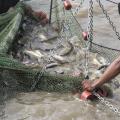Biology of Catfish
The channel catfish is a member of the family Ictaluridae--the North American catfishes--which comprises seven genera and at least 45 species. Many are fine table fish, but the channel catfish accounts for virtually all of the commercial foodfish production in the United States.
 Channel catfish are native to central North America between the Rocky and Appalachian mountains, from the Gulf of Mexico north to the Hudson Bay drainage. They are popular sport fish, and have been widely introduced throughout North America. The fish is slender and scaleless, with a gently sloping dorsal profile anterior of the dorsal fin. Normally pigmented fish are white to silvery on the undersides shading to grayish blue or olivaceous to nearly black dorsally. Albino channel catfish are a beautiful peach color. Albinism is rare in wild fish, but is not uncommon in certain domesticated strains. Irregular dark spots are present on the sides of young fish, but are absent in albino fish and are often lost in normally pigmented fish over about one pound. Eight barbels--four dorsal and four ventral--are located around a subterminal mouth. Channel catfish have soft-rayed fins; however, the pectoral and dorsal fins contain sharp spines. The anal fin, which is used to distinguish channel catfish from closely related species, is rounded and contains 24 to 30 rays. Another distinguishing characteristic is the deeply-forked tail, although the depth of the fork may be much reduced in older fish, especially in large breeding males.
Channel catfish are native to central North America between the Rocky and Appalachian mountains, from the Gulf of Mexico north to the Hudson Bay drainage. They are popular sport fish, and have been widely introduced throughout North America. The fish is slender and scaleless, with a gently sloping dorsal profile anterior of the dorsal fin. Normally pigmented fish are white to silvery on the undersides shading to grayish blue or olivaceous to nearly black dorsally. Albino channel catfish are a beautiful peach color. Albinism is rare in wild fish, but is not uncommon in certain domesticated strains. Irregular dark spots are present on the sides of young fish, but are absent in albino fish and are often lost in normally pigmented fish over about one pound. Eight barbels--four dorsal and four ventral--are located around a subterminal mouth. Channel catfish have soft-rayed fins; however, the pectoral and dorsal fins contain sharp spines. The anal fin, which is used to distinguish channel catfish from closely related species, is rounded and contains 24 to 30 rays. Another distinguishing characteristic is the deeply-forked tail, although the depth of the fork may be much reduced in older fish, especially in large breeding males.
Channel catfish thrive in a variety of habitats, from clear, swiftly flowing streams to sluggish rivers, lakes, and ponds. They are bottom dwellers that prefer a substrate of sand and gravel. In nature, channel catfish are opportunistic omnivores, and use food items in proportion to availability. Young fish feed primarily on aquatic detritus, aquatic insects, and zooplankton; adults feed primarily on aquatic insects, freshwater crayfish, and small fish.
Channel catfish tolerate a wide range of environmental conditions. The optimum water temperature for growth is 75 to 85º F, but fish can survive at temperatures from just above freezing to nearly 100º F. Growth is slow at temperatures less than 65º F and feeding activity essentially stops at temperatures below about 50º F. The maximum water temperature at which channel catfish can survive indefinitely is about 95º F and fish survive only briefly at temperatures above 100º F. Adult channel catfish tolerate salinities from near 0 to 11 parts per thousand (ppt), although salinities less than 4 ppt are preferred. Eggs tolerate salinities as high as 16 ppt but hatch only at 8 ppt or less.
Age at sexual maturity varies from 2 to 12 years, depending on the length of the growing season (fish generally mature faster in warmer climates). In nature, from 2 to 4 years may be required to reach a weight of 1 pound, although growth rate depends on temperature and food availability. Channel catfish may live over 20 years and attain weights in excess of 40 pounds.
Channel catfish possess a combination of biological and cultural attributes that make them an excellent fish for commercial aquaculture. Channel catfish usually do not reproduce in culture ponds, giving the culturist control over pond populations. This is important because uncontrolled reproduction can lead to overabundance of fish, which may reduce the yield of marketable fish. Sexually mature fish are, however, easily spawned under proper conditions and large numbers of fry can be obtained using simple methods. Fry accept manufactured feeds at first feeding after absorbing the yolk-sac, and growth and feed conversion efficiency on relatively simple manufactured feeds is good in all phases of production. Channel catfish are relatively hardy fish that tolerate crowding and a wide range of environmental conditions. They also adapt well to all commonly used aquaculture production systems--ponds, cages, and raceways. Channel catfish have firm, white flesh with a mild flavor that retains high sensory quality after a variety of processing methods.
MSU Publications & Information
Other Catfish Biology Information
- Channel Catfish: Life History and Biology
SRAC Fact Sheet No. 180 - Additional Southern Regional Aquaculture Center Fact Sheets
Publications
News
STARKVILLE, Miss.
Coastal wetland conservation and restoration projects along the Mississippi Gulf Coast and beyond are running into a distinct challenge: there often aren’t enough locally sourced native plants readily available to complete these efforts.
The Mississippi State University Extension Service is meeting this problem head-on by enlisting plant enthusiasts to grow and sell these marsh plants. The effort is organized as the Native Plant Producer Network, or NPPN, and it was started in 2023.
STARKVILLE, Miss. -- Lower feed prices are providing some relief to Mississippi’s catfish producers, but many are still facing more than their share of obstacles just to break even.




